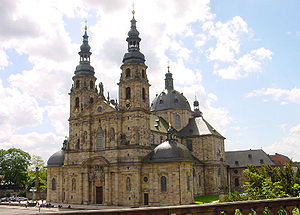
Fulda witch trials
Encyclopedia

Fulda
Fulda is a city in Hesse, Germany; it is located on the river Fulda and is the administrative seat of the Fulda district .- Early Middle Ages :...
in Germany
Germany
Germany , officially the Federal Republic of Germany , is a federal parliamentary republic in Europe. The country consists of 16 states while the capital and largest city is Berlin. Germany covers an area of 357,021 km2 and has a largely temperate seasonal climate...
in the years from 1603 to 1606 was one of the biggest witch trials in Europe
Europe
Europe is, by convention, one of the world's seven continents. Comprising the westernmost peninsula of Eurasia, Europe is generally 'divided' from Asia to its east by the watershed divides of the Ural and Caucasus Mountains, the Ural River, the Caspian and Black Seas, and the waterways connecting...
together with the Trier witch trials
Trier witch trials
The Witch trials of Trier in Germany in the years from 1581 to 1593 was the perhaps biggest witch trial in Europe. The persecutions started in the diocese of Trier in 1581 and reached the city itself in 1587, where it was to lead to the death of about three hundred and sixty eight people, and was...
1587-1593 and Quedlinburg
Quedlinburg
Quedlinburg is a town located north of the Harz mountains, in the district of Harz in the west of Saxony-Anhalt, Germany. In 1994 the medieval court and the old town was set on the UNESCO world heritage list....
in 1589. It was to lead to the death of about two hundred and five people, and was as such one of the biggest mass-executions in peace time.
The witch trial
The witch trials of the diocese of Fulda can be described as a part of the counter-reformationCounter-Reformation
The Counter-Reformation was the period of Catholic revival beginning with the Council of Trent and ending at the close of the Thirty Years' War, 1648 as a response to the Protestant Reformation.The Counter-Reformation was a comprehensive effort, composed of four major elements:#Ecclesiastical or...
. The person responsible was the Prince Bishop Balthasar von Dernbach, who ordered for the witch hunt as a part of re-catholicizing the diocese after a period of religious liberalism.
Dernbach was born into a noble family as the son of a Protestant and a Catholic; when his father died, his Catholic mother sent him to be raised by stern Catholics, and he became a Fanatic. He was appointed ruling Prince Bishop in 1570, but deposed in 1576, after which he was replaced with a Prince Bishop who issued a law of freedom of religion. When Dernbach was re-elected as regent in 1602, he ordered for an investigation of sorcery as a way of purging the city form everything he deemed as improper. The investigation began in March 1603, and shortly thereafter, the arrests begun in the city. Hundreds of people were to die before the witch trials ended, many of them being burnt alive at the stake.
Victims of the Fulda witch trial
- 1603: Merga BienMerga BienMerga Bien was an alleged German witch, perhaps the most famous of the many victims in the great mass Fulda witch trials in Germany in 1603–1605....
, the most well-known victim. - June 1604: Nine women burned alive.
- August 1604 : Nine women burned alive.
- September 1604 : Eleven women burned alive.
- September 1604 : Twelve women burned alive.
- October 1604 : Ten women burned alive.
- December 1604 : Eight women burned alive.
- May 1605 : Thirteen women burned alive.
- June 1605 : Twelve women burned alive.
- July 1605 : Twelve women burned alive.
- August 1605 : Twelve women burned alive.
- October 1605 : Ten women burned alive.
- November 1605: Eleven women burned alive.
- March 1606: Seven women burned alive.
The 15 March 1605 the Prince Bishop Balthasar von Dernbach died and his government over Fulda was dissolved, and soon, the witch hunts ended.

